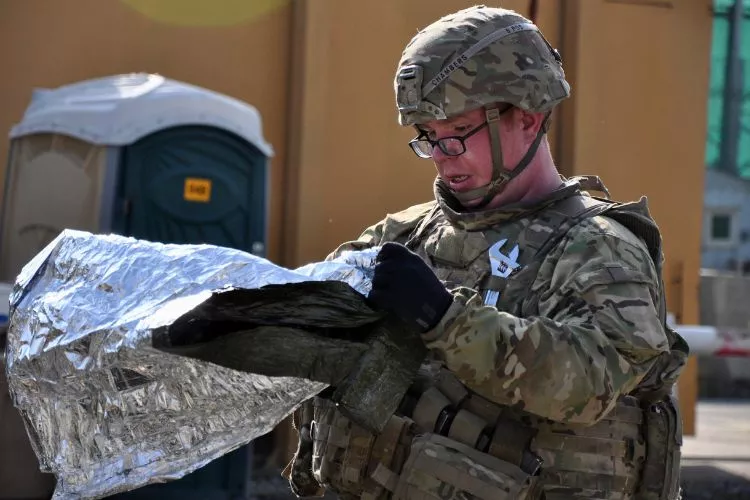The magic of space blankets, used by astronauts, fascinates many. These metallic sheets resist extreme cold in the chilling vacuum of outer space. What about their use here on Earth?
Would they help keep your ice cream from melting on a blisteringly hot day? Do space blankets keep things cold? Let’s find out.

Let us explore the captivating world of space blankets, delving deep into how they function and their efficacy in keeping things cold.
Do space blankets keep things cold?
Yes, space blankets can help keep things cold. Here’s why. Space blankets use a material called Mylar. This material reflects heat.
When you wrap something cold, like a beverage, ice cream, or even food in a space blanket, the Mylar material helps it stay cold. It does this by reflecting the heat of the environment away from what is wrapped.
This prevents the wrapped item from absorbing heat, which would warm it up. Keep in mind; the blanket does not actively cool items.
It prevents heat from getting to them. So, if you start with a cold item, the space blanket helps to keep it that way.
How long do space blankets keep things cold?
The length of time a space blanket can keep things cold depends on a few factors. One is the temperature outside the blanket. Another is how well the item was chilled before the wrap.
Yet another factor is how well you wrap the item. It is hard to give an exact time. Still, in very hot conditions — say, a summer day at the beach — a space blanket can keep a chilled item like a drink cold for about a couple of hours if properly wrapped.
Remember that a space blanket doesn’t chill things, but it helps to slow down the process of warming up. It is always best to start with a very cold item if you want to keep it cold as long as possible.
Maximizing the Cold-Keeping Abilities of Space Blankets
To get the most out of space blankets for temperature preservation, follow these tips and tricks. Boost their potential to keep items cold by using these smart approaches.

Start with a Pre-Chilled Item
Temperature preservation begins with the item itself. Make sure it’s already cold before you wrap it. Space blankets don’t produce cold; they only reflect heat. So, the colder the item, the longer it will stay cold inside the blanket.
Proper Wrapping Technique
Wrap your cold items tightly and securely. Cover all surfaces with the Mylar material to prevent heat from entering. Fewer gaps mean better insulation. Sealing with tape can ensure a tighter wrap.
Combine Space Blankets with Insulated Containers
A two-step method can improve cold-keeping abilities. First, wrap your item with a space blanket. Next, place it inside an insulated container like a cooler or thermos.
The combination of a Mylar barrier and an insulated container will keep items cold for longer. Adding ice packs to the cooler can also help.
Keep Out Direct Sunlight
Maintain the effectiveness of your space blanket by keeping wrapped items out of direct sunlight. The sun’s heat can eventually wear down the insulating properties of the Mylar material. Move your items to a shaded area or keep them under cover.
Use Multiple Layers
When insulation is critical, layering can help. Wrap your cold item with two or more space blankets, one on top of another. Each layer acts as an extra barrier, reducing heat transfer and improving insulation.
Keep In Mind the External Temperature
In very hot environments, it’s essential to be aware of the heat around you. No amount of insulation can keep an item cold indefinitely in extreme heat. Pair your space blanket with a shade or even an umbrella to help maintain cooler surroundings.
Reuse and Repurpose
If you notice your wrapped item starting to lose its chill, don’t throw the space blanket away. Unwrap, reuse, or repurpose your Mylar blanket—it’s a versatile material with more than just one use.
By following these simple tips, you can maximize the cold-keeping abilities of space blankets. From picnics to beach trips, space blankets can significantly improve your temperature preservation game.
Other survival guide related to food: How Much Food Do You Need to Survive?
Comparing Different Insulation Materials
An understanding of different insulation materials and their effectiveness is useful. Normal home insulation materials and special materials like those in space blankets all have unique abilities when it comes to keeping items cold.
Traditional Insulations: Foam, Fiberglass, and Rock Wool
Foam, fiberglass, and rock wool are common home insulation materials. They work well over large areas and are good at regulating home temperatures. But, they are bulky and not ideal for portable use to keep things cold.
Natural Materials: Wool and Down Feathers
Wool is good at retaining heat, making it an efficient insulator. Down feathers, used in high-quality winter wear and bedding, provide good insulation. But like traditional materials, they lack portability and can’t be used to wrap things.
Synthetic Materials: Neoprene and Polystyrene
Neoprene, used in wet suits, has good insulating properties. It is flexible but not ideal for wrapping things. Polystyrene is used in disposable coolers and cups. It is lightweight and cheap but can harm the environment.
Hi-Tech Material: Aerogel
Aerogel, a cutting-edge insulator, is potent. It’s flexible, lightweight, and small—perfect for space. But it is expensive and not available for daily use.
Mylar: Space Blankets
Space blankets, made of Mylar, have a key benefit: they can wrap around items. Mylar is flexible, lightweight, and waterproof. It’s also a great insulator, reflecting more than 90% of radiant heat.
We’ve covered a range of insulators, each with its pros and cons. Foams, wools, and aerogel can insulate well, but they lack the ease of use and flexibility of Mylar.
Mylar-based space blankets are an excellent option for portable insulation to keep chilled items cold. They’ve made a name in space, and they certainly shine here on Earth, too, in their unique way.
How Mylar Material Works?
Understanding Mylar, the key material in space blankets, gives us insights into their amazing performance in temperature control. Mylar is unique, powerful, and versatile.

What is Mylar?
Mylar is a type of polyester film. It’s known for its strength, flexibility, and ability to resist temperatures and chemicals. This material is clear and thin yet potent. It’s used in many areas, from food packaging to space technology.
Mylar and Heat Reflection
Space blankets are also known as Mylar blankets due to the material used. One of Mylar’s key features is how it handles heat. The material reflects heat, pushing it back in the direction it came from.
That’s why space blankets can prevent body heat loss in emergency situations. It’s also why they can keep items cold by reflecting environmental heat away.
Mylar in Space Blankets
Mylar is used as a thin film in space blankets. It’s coated with a metallic layer, usually aluminum. This method enhances Mylar’s heat-reflecting properties. The material becomes shiny and metallic, giving space blankets their distinctive appearance.
Insulation and Mylar
The heat-reflecting traits of Mylar make it a powerful insulating material. It helps keep hot items hot and cold items cold. Mylar can be an effective barrier against heat transfer, be it from a hot summer day or a cold winter night.
So, when you wrap a cold item in a space blanket, the Mylar is at work. It reflects away the external heat, keeping the item from warming up. Conversely, if you wrap a hot item, Mylar reflects the item’s heat inward, preventing it from cooling down.
Mylar’s Limitations
Despite being an excellent heat barrier, Mylar does have limitations. It can’t cool items down or heat them up. It reflects heat, preventing or slowing temperature changes.
Therefore, the initial temperature of the item is essential. If you want to keep a drink cold on a hot day, it’s better to start with a super chilled drink.
Mylar in space blankets works as a mirror for heat. It reflects heat away, making it an excellent insulator. It’s a simple but effective approach to temperature control. Whether in space or on a summer picnic, Mylar can make a real difference.
Conclusion:
In conclusion, space blankets, made from highly reflective Mylar material, can indeed maintain the cold temperature of items by effectively reflecting away external heat.
Although they don’t possess cooling abilities, their exceptional ability to act as a barrier to heat transfer helps in preserving initial temperatures for extended periods.
Practical practices, such as proper wrapping and using pre-chilled items, can enhance the cold-keeping abilities of space blankets. This knowledge underlines their versatility not only in emergency and space applications but also in everyday insulation needs.


